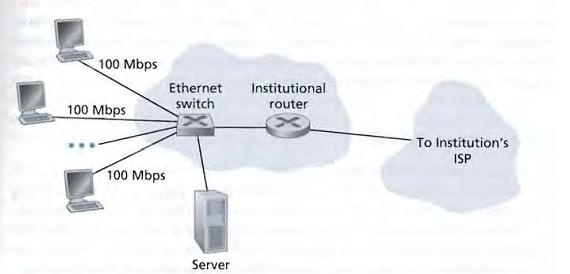1. Dial-Up
Back in the 1990s, almost all residential users accessed the Internet over ordinary analog telephone lines using a dial-up modem.
The term "dial-up" is employed because the user's software actually dials an ISP's phone number and makes a traditional phone connection with the ISP. As shown in following picture.

Dial-Up Internet access
2. DSL
Today the two most prevalent types of broadband residential access are digital subscriber line(DSL) and cable.

DSL Internet Access
3. Cable
Many residences in the North America and elsewhere receive hundreds of broadcast television channels over coaxial cable networks.
Cable Internet access makes use the cable television company's existing cable television infrastructure. A residence obtains cable Internet access from the same company that provides it cable television. as the following Figure.

A hybrid fiber-coaxial access network
4. Fiber-To-The-Home(FTTH)
Fiber optics can offer significantly higher transmission rates than twisted-pair copper wire or coaxial cable.
Some local telcos(in many different countries), having recently laid optical fiber from their COs to homes, now
provide high-speed Internet access as well as traditional phone and television services over the optical fibers.
The following figure shows FTTH using the PON distribution architecture. Each home has an optical network terminator(ONT),
which is connected by dedicated optical fiber to a neighborhood splitter, the splitter combines a number of homes ont o a single,
shared optical fiber, whichi connects to an optical line terminator(OLT) in the telco's CO. The OLT, providing conversion between
optical and electrical signals, connects to the Internet via a telco router.
In the home, users connect a home router(typically a wireless routor) to the ONT and access the Internet via this home router.
In the PON architecture, all packets sent from OLT to the splitter are replicated at the splitter(similar to a cable head end).

FTTH Internal Access
5. Ethernet
On corporate and university campuses, a local area network(LAN) is typically used to connect an end system to the edge router.Although, there are
many types of LAN technologies, Ethernet is by far the most prevalent access technology in corporate and university networks.
as the follow figure shown.
Ethernet Internal Access
Ethernet users use twisted-paire copper wire to connect to an Ethernet switch.
7. WIFI
Increasingly, people access the Internet wirelessly, either through a laptop computer of from a mobile handheld device.
Today, there are two common types of wireless Internet access, In a wireless LAN, wireless users transmit/receive packets to/from
an access point that in turn is connected to the wired Internet. A wireless LAN user must typically be within a few tens of meters of the access point.
In wide-area wireless access networks, packets are transmitted to a base station over the same wireless infrastructure used for cellular telephony.
Wireless LAN access base on IEEE 802.11 technology, that is WIFI, is now just about everywhere - universities, business offices, cafes,airports,homes,
and even in airports.
8.Wide-Area wireless Access
When you access the Internet through wireless LAN technology, you typically need to be within a few tens of meters of access point
.This is feaible for home access, coffee shop access, and more generally, access within and around a building.
Telecommunications companies have made enormous investments in so-called third generation(3G) wireless, which provides packet-switched
wide-area wireless Internet access at speeds in excess of 1Mbps. Today millions of users are using these networks to read and send
email, surf the web adn download music while on the run.
9. WiMAX
There is a potential "killer" technology waiting to dethrone these standards, WiMAX, also known as IEEE802.16, is a long-distance cousin
of the 802.11 WiFi protocol discussed above.
来自“Computer Networking:A top to down approach”
分享到:















相关推荐
接入网技术(Local Access Network Technologies)----经典图书,作为通讯接入网的入门级教程,希望对大家有所帮助 属于chm格式,无需解压,直接阅读
HCNP-Access Network认证定位于接入网的构建和管理。 HCNP-Access Network认证包括但不限于:PON、xDSL、数据通信基本原理、SNMP、网管系统、组网保护、DHCP/PPPoE、常见故障处理、产品硬件结构及特性、FTTx规划...
在无线通信里,接入网一般指无线接入网:RAN(Radio Access Network)。 2、5G接入网概念 5G无线接入网NR总体架构 5GC NG-RAN 3、5G接入网的组成-1 E-UTRAN:只有一种节点网元—eNodeB。 EPC E-UTRAN LTE无线接入网...
华为HCIA-Access【接入网】_培训教材和实验指导手册
华为HCIP-Access【接入网】培训教材与实验指导手册.zip
一般地说,通信网包含核心网(Core network)(也即骨干网,backbone)和接入网(access network)两大部分。例如一个大城市,必有市内通信网(常称市内电话网,local telephone network),它分若干地区设立若干...
华为HCIP-Access V2.5接入网培训教材和实验指导
内容含盖了目前常用的接入设备的型号及原理,以及相关故障告警处理流程等。
传输容量大 传输损耗小 泄露小,保密性好 节省有色金属 …… 光接入网(OAN,Optical Access Network) 在接入网中采用光纤作为主要传输媒质的接入技术 三网融合光接入 光接入网技术 功能参考模型 应用类型 按照ONU...
2793-2015接入网技术要求GPON/ XG-PON ONU管理和控制接口(OMCI) Technical requirements for access network gigabit- capable passive optical network (GPON) / 10 gigabit-capable passive optical network ...
This paper presents the results of a detailed survey on the fifth generation (5G) cellular network architecture and some of the key emerging technologies that are helpful in improving the ...
Python连接Access数据库Python连接Access数据库Python连接Access数据库Python连接Access数据库Python连接Access数据库Python连接Access数据库Python连接Access数据库Python连接Access数据库Python连接Access数据库...
Technical Specification Group GSM/EDGE Radio Access Network;General Packet Radio Service (GPRS);Mobile Station (MS) - Base Station System (BSS) interface;...3GPP 发布的GSM/EDGE接入网标准,英文。
access接入终端设备
HCAN011接入网概述pp HCAN012TCpP基础.pptK HCAN013以太网概述PPt区 HCAN014VLAN技术原理pptx HCAN015路由基础PPtk HCAN016EPON原理Ppt HCANO17GPON原理ppt HCAN01 8 FTTx系系统述pptx HCAN019 GPON OLT基本操作ppt
Windows Server 2008的Network Access Protection介绍
在无线通信里,接入网一般指无线接入网:RAN(Radio Access Network)。 2、5G接入网概念 5G无线接入网NR总体架构 5GC NG-RAN 3、5G接入网的组成-1 E-UTRAN:只有一种节点网元—eNodeB。 EPC E-UTRAN LTE无线接入网...
wpf连接access数据库,listview显示数据 ,还有数据绑定
The authors provide a comprehensive overview of the 5G RAN design guidelines, key design considerations, and functional innovations as identified and developed by key players in the field....